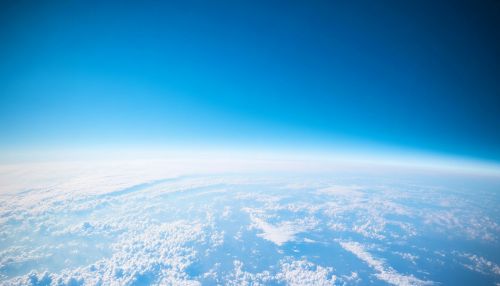Stratospheric Ozone: Difference between revisions
(Created page with "== Introduction == The stratospheric ozone layer is a crucial component of Earth's atmosphere, primarily located in the lower portion of the stratosphere, approximately 10 to 50 kilometers above the Earth's surface. This layer plays a vital role in protecting life on Earth by absorbing the majority of the sun's harmful ultraviolet radiation, particularly the more dangerous UV-B and UV-C wavelengths. The presence and health of the s...") |
No edit summary |
||
| Line 25: | Line 25: | ||
Thanks to these global efforts, there are signs of recovery in the stratospheric ozone layer. Satellite data and ground-based observations indicate that ozone levels are stabilizing and, in some regions, beginning to increase. Full recovery of the ozone layer is projected to occur by the middle of the 21st century, assuming continued compliance with the Montreal Protocol. | Thanks to these global efforts, there are signs of recovery in the stratospheric ozone layer. Satellite data and ground-based observations indicate that ozone levels are stabilizing and, in some regions, beginning to increase. Full recovery of the ozone layer is projected to occur by the middle of the 21st century, assuming continued compliance with the Montreal Protocol. | ||
[[Image:Detail-98501.jpg|thumb|center|Clear blue sky with a view of the Earth’s horizon from the stratosphere, showing a thin layer of ozone.|class=only_on_mobile]] | |||
[[Image:Detail-98502.jpg|thumb|center|Clear blue sky with a view of the Earth’s horizon from the stratosphere, showing a thin layer of ozone.|class=only_on_desktop]] | |||
== Impact on Climate Change == | == Impact on Climate Change == | ||
Latest revision as of 05:14, 18 October 2024
Introduction
The stratospheric ozone layer is a crucial component of Earth's atmosphere, primarily located in the lower portion of the stratosphere, approximately 10 to 50 kilometers above the Earth's surface. This layer plays a vital role in protecting life on Earth by absorbing the majority of the sun's harmful ultraviolet radiation, particularly the more dangerous UV-B and UV-C wavelengths. The presence and health of the stratospheric ozone layer have been subjects of significant scientific study and environmental policy-making, especially since the discovery of its depletion in the late 20th century.
Formation and Composition
Ozone (O₃) is a molecule composed of three oxygen atoms. It forms in the stratosphere through a series of photochemical reactions. The process begins when solar radiation splits molecular oxygen (O₂) into individual oxygen atoms. These free oxygen atoms can then react with other O₂ molecules to form ozone. This cycle of ozone creation and destruction is known as the ozone-oxygen cycle and is crucial for maintaining the balance of ozone in the stratosphere.
The concentration of ozone is not uniform throughout the stratosphere. It is most dense between 15 and 35 kilometers above the Earth's surface, a region often referred to as the "ozone layer." The thickness of this layer varies geographically and seasonally, influenced by factors such as latitude, altitude, and atmospheric circulation patterns.
Role in UV Radiation Absorption
The stratospheric ozone layer absorbs approximately 97-99% of the sun's medium-frequency ultraviolet light, which is potentially damaging to life forms. The absorption of UV radiation by ozone is a critical function, as it prevents these rays from reaching the Earth's surface in harmful quantities. UV-B radiation, in particular, can cause skin cancer, cataracts, and other health issues in humans, as well as detrimental effects on ecosystems, including marine life and terrestrial plants.
Ozone Depletion
The depletion of the stratospheric ozone layer became a major environmental concern in the late 20th century, primarily due to human activities. The release of chlorofluorocarbons, halons, and other ozone-depleting substances (ODS) into the atmosphere led to significant reductions in ozone concentrations. These compounds release chlorine and bromine atoms in the stratosphere, which catalyze the breakdown of ozone molecules.
The most notable manifestation of ozone depletion is the ozone hole over Antarctica, first observed in the 1980s. This phenomenon is characterized by a substantial thinning of the ozone layer during the Southern Hemisphere's spring (September to November). The unique meteorological and chemical conditions in the Antarctic stratosphere, such as the presence of polar stratospheric clouds, exacerbate the depletion process.
International Response and Recovery Efforts
The alarming discovery of ozone depletion prompted a swift international response, leading to the adoption of the Montreal Protocol on Substances that Deplete the Ozone Layer in 1987. This treaty, widely regarded as one of the most successful environmental agreements, mandated the phase-out of CFCs and other ODS. The protocol has been amended several times to include additional substances and accelerate phase-out schedules.
Thanks to these global efforts, there are signs of recovery in the stratospheric ozone layer. Satellite data and ground-based observations indicate that ozone levels are stabilizing and, in some regions, beginning to increase. Full recovery of the ozone layer is projected to occur by the middle of the 21st century, assuming continued compliance with the Montreal Protocol.


Impact on Climate Change
The relationship between stratospheric ozone and climate change is complex and multifaceted. Ozone itself is a greenhouse gas, and changes in its concentration can influence the Earth's radiative balance. The depletion of ozone has led to cooling in the stratosphere, which can affect atmospheric circulation patterns and, consequently, climate systems.
Moreover, many ODS are also potent greenhouse gases. The reduction of these substances under the Montreal Protocol has contributed to mitigating climate change. The protocol's impact on climate is considered one of its ancillary benefits, as it has prevented the emission of greenhouse gases equivalent to several billion tonnes of CO₂.
Future Challenges and Research Directions
While the recovery of the stratospheric ozone layer is a positive development, several challenges remain. The potential for geoengineering solutions, such as the deliberate injection of aerosols into the stratosphere to combat climate change, raises concerns about unintended impacts on ozone chemistry. Additionally, the increasing use of hydrofluorocarbons, which are not ozone-depleting but are powerful greenhouse gases, poses a new challenge for both ozone protection and climate mitigation efforts.
Ongoing research is crucial to understanding the interactions between ozone recovery, climate change, and atmospheric dynamics. Scientists continue to monitor ozone levels, study the effects of emerging pollutants, and refine models to predict future changes in the stratosphere.
